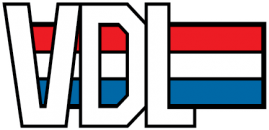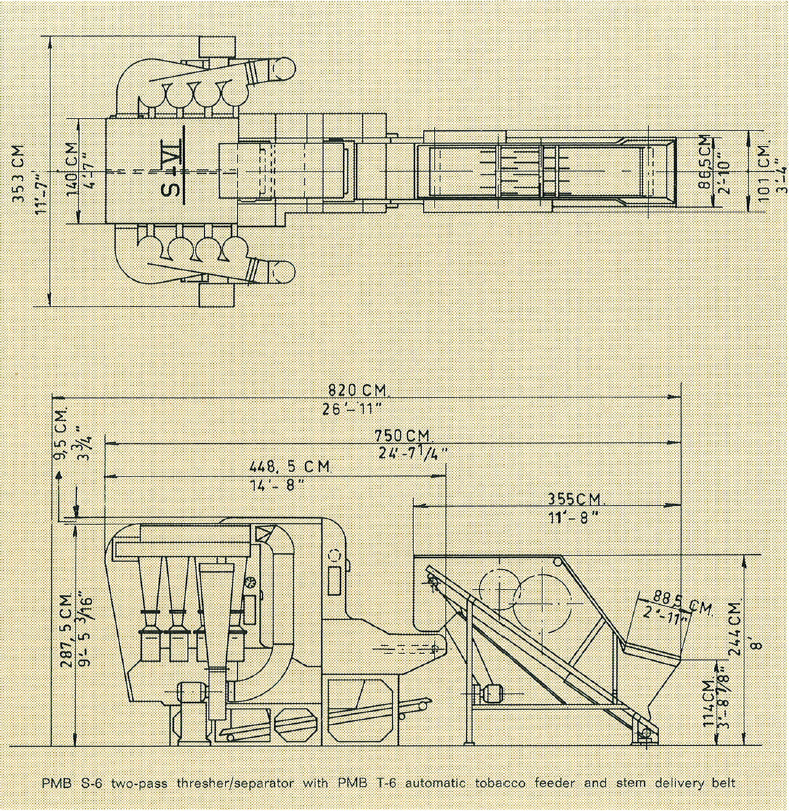Introduction of the Thresher S6, S8 and S10
It is a well-known fact that it is impossible to entirely thresh and separate leaf tobacco in one single operation.
Even if the threshing is done so well that the stems are entirely free of laminae, it will be technically not possible to separate stems and leaf during the first operation.
The smaller the threshed tobacco has to be the less it will have to be processed in following passes. If uniformity of size and a low percentage of smalls are required proportionally more passes will be necessary.
Design and Operating priciple
In the thresher/separator S-6, S-8 and S-10 two completely separate passes are brought together into one machine taking up little floor space. These compact two-pass units are ideal for smaller factories and when assembling complete tobacco preparation plants.
This type of equipment also has more possibilities than the single-pass machines, e.g. the pre-separating system, in which the first thresher does not serve primarily for threshing, but chiefly to separate the loose leaf particles from the tobacco to be threshed. Hence,· these laminae are separated without making more shorts in the first pass. If great value is attached to large laminae, this pre-separation system will prove to be very useful.
Machine features
1. Two entirely independent operations
The machine has 2 separate threshing units, for the first and the second pass respectively, each with long, narrow, easily interchangeable maces mounted onto the shaft. The standard maces are symmetrical and made of case hardened steel.
2. Lamina size
The size of the laminae depends on the condition of the tobacco. If it is too wet the thresher will either quickly seize up and/or produce irregular laminae. If it is too dry, a lot of shorts will result. Correct humidity, different for every type of tobacco,therefore is most important. Additionally it is essential that the tobacco should be brought from the first to the second pass by the shortest possible route to avoid drying out. In the S-6 this is done by means of a fast, short conveyor built into and partly covered by the frame of the machine. Furthermore, to obtain equally sized laminae the load on every thresher should not vary.
3. Sand and dust
Light-weight dust is carried along by the air current and ends up in the cyclones (dedusting effect approx. 94-96 %), where it is removed in the usual way. Underneath the cyclones there are easily detachable dust containers. The heavier dust can drop away behind the sieves in the expansion boxes to be collected in a bin. Sand is eliminated through the perforated plate over which the laminae slide towards the air-lock.
4. Safe operation
All motors are dust proof and protected by thermal cut-outs. A central switch cupboard with automatic star/delta switches and pushbutton operation is recommended. Microswitches connected to the covers over Threshing shaft with long maces the threshing units and to the brake handle which will stop both threshers immediately in case of emergency will cut off the current to the drive motor and prevent switching on as long as the covers are open. The air-locks underneath the expansion boxes are mechanically protected against damage in case of a tobacco build-up. The same mechanical protection is fitted to the lock underneath the secondary grate of the first pass.
5. Extra equipment
Stem removing belts in several lengths are available for the two-pass thresher/separator S-6. They will be mounted into the frame and powered by the machine. The dust-cyclones may be placed elsewhere. However, this will have to be calculated individually because of the limited output of the standard fans. The choice of the grates will depend on local requirements. For general purpose operation standard sets of grates are available.
6. Automatic feed
The output of the VDL PMB S-6 is so high, that it is next to impossible to feed it by hand. Hence, a special automatic feeder T-6, shown in a separate prospectus and the sketch overleaf was developped for the S-6.
Machine specifications
TECHNICAL DATA S6
Input:
Dependent on type of tobacco, approx. 300-500 kgs/hour in first stage, based on 11 % moisture content of the raw material
Motors:
2 motors, each 7 .5 hp, 3.000 rpm for the 2 fans; 1 motor 10 hp, 1.500 rpm to drive the machine
Power consumption: 26.5 kVA, including the illumination of the separating shafts and inside the expansion boxes
Dimensions:
Length 449 cm (14'-8"), width 360 cm (11'-7"), height 297 cm (9'-9")
Weight:
Nett 4.600 kg (10120 lb.)
gross 6.725 kg (14795 lb.)
Shipping volume:
44 m3 (1554 cbft)
TECHNICAL DATA S8
Input:
Dependent on type of tobacco, approx. 500-900 kg/hour in first stage, based on 11 % moisture content of the raw material
Motors:
2 motors, each 10 hp, 3.000 rpm for the 2 fans; 1 drive motor 15 hp, 1.500 rpm; 1 drive motor, 10 hp, 1.500 rpm; 2 motor reductors to drive the dust conveyor screws, 0.33 hp each Power consumption: 54 kVA. including the illumination of the separating shafts and the inside of the expansion boxes
Dimensions:
length 479 cm (15' -9"), width 375 cm (12' -4"); height 298 cm (9' -9”)
Weight:
Nett 7.144 kg (14.244 lb)
Gross 10.100 kg (22.270 lb)

